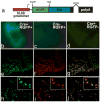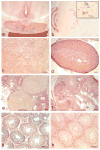Pitx2 deletion in pituitary gonadotropes is compatible with gonadal development, puberty, and fertility
- PMID: 18802953
- PMCID: PMC2923441
- DOI: 10.1002/dvg.20398
Pitx2 deletion in pituitary gonadotropes is compatible with gonadal development, puberty, and fertility
Abstract
This report introduces a gonadotrope-specific cre transgenic mouse capable of ablating floxed genes in mature pituitary gonadotropes. Initial analysis of this transgenic line, Tg(Lhb-cre)1Sac, reveals that expression is limited to the pituitary cells that produce luteinizing hormone beta, beginning appropriately at e17.5. Cre activity is detectable by a reporter gene in nearly every LHbeta-producing cell, but the remaining hormone-producing cell types and other organs exhibit little to no activity. We used the Tg(Lhb-cre)1Sac strain to assess the role Pitx2 in gonadotrope function. The gonadotrope-specific Pitx2 knockout mice exhibit normal expression of LHbeta, sexual maturation, and fertility, suggesting that Pitx2 is not required for gonadotrope maintenance or for regulated production of gonadotropins.
Copyright 2008 Wiley-Liss, Inc.
Figures




Similar articles
-
Fshb-iCre mice are efficient and specific Cre deleters for the gonadotrope lineage.Mol Cell Endocrinol. 2016 Jan 5;419:124-38. doi: 10.1016/j.mce.2015.10.006. Epub 2015 Oct 22. Mol Cell Endocrinol. 2016. PMID: 26472536 Free PMC article.
-
NR5A2 regulates Lhb and Fshb transcription in gonadotrope-like cells in vitro, but is dispensable for gonadotropin synthesis and fertility in vivo.PLoS One. 2013;8(3):e59058. doi: 10.1371/journal.pone.0059058. Epub 2013 Mar 11. PLoS One. 2013. PMID: 23536856 Free PMC article.
-
Deletion of Gαq/11 or Gαs Proteins in Gonadotropes Differentially Affects Gonadotropin Production and Secretion in Mice.Endocrinology. 2022 Feb 1;163(2):bqab247. doi: 10.1210/endocr/bqab247. Endocrinology. 2022. PMID: 34864945 Free PMC article.
-
Embryonic development of gonadotrope cells and gonadotropic hormones--lessons from model fish.Mol Cell Endocrinol. 2014 Mar 25;385(1-2):18-27. doi: 10.1016/j.mce.2013.10.016. Epub 2013 Oct 18. Mol Cell Endocrinol. 2014. PMID: 24145126 Review.
-
Mouse Models of Gonadotrope Development.Prog Mol Biol Transl Sci. 2016;143:1-48. doi: 10.1016/bs.pmbts.2016.08.001. Epub 2016 Sep 12. Prog Mol Biol Transl Sci. 2016. PMID: 27697200 Review.
Cited by
-
Maximal expression of Foxl2 in pituitary gonadotropes requires ovarian hormones.PLoS One. 2015 May 8;10(5):e0126527. doi: 10.1371/journal.pone.0126527. eCollection 2015. PLoS One. 2015. PMID: 25955311 Free PMC article.
-
Molecular mechanisms of pituitary organogenesis: In search of novel regulatory genes.Mol Cell Endocrinol. 2010 Jul 8;323(1):4-19. doi: 10.1016/j.mce.2009.12.012. Epub 2009 Dec 16. Mol Cell Endocrinol. 2010. PMID: 20025935 Free PMC article. Review.
-
Long Noncoding RNAs Expressed in Mouse Pituitary Development and Mature Hormone-Producing Cells.Endocrinology. 2024 Oct 30;165(12):bqae147. doi: 10.1210/endocr/bqae147. Endocrinology. 2024. PMID: 39487735
-
FOXO1 transcription factor inhibits luteinizing hormone β gene expression in pituitary gonadotrope cells.J Biol Chem. 2012 Sep 28;287(40):33424-35. doi: 10.1074/jbc.M112.362103. Epub 2012 Aug 3. J Biol Chem. 2012. PMID: 22865884 Free PMC article.
-
All Hormone-Producing Cell Types of the Pituitary Intermediate and Anterior Lobes Derive From Prop1-Expressing Progenitors.Endocrinology. 2016 Apr;157(4):1385-96. doi: 10.1210/en.2015-1862. Epub 2016 Jan 26. Endocrinology. 2016. PMID: 26812162 Free PMC article.
References
-
- Berger P, Kranewitter W, Madersbacher S, Gerth R, Geley S, Dirnhofer S. Eutopic production of human chorionic gonadotropin beta (hCG beta) and luteinizing hormone beta (hLH beta) in the human testis. FEBS Lett. 1994;343:229–233. - PubMed
-
- Bingham NC, Verma-Kurvari S, Parada LF, Parker KL. Development of a steroidogenic factor 1/Cre transgenic mouse line. Genesis. 2006;44:419–424. - PubMed
-
- Brinkmeier ML, Gordon DF, Dowding JM, Saunders TL, Kendall SK, Sarapura VD, Wood WM, Ridgway EC, Camper SA. Cell-specific expression of the mouse glycoprotein hormone alpha-subunit gene requires multiple interacting DNA elements in transgenic mice and cultured cells. Mol Endocrinol. 1998;12:622–633. - PubMed
-
- Burns KH, Matzuk MM. Minireview: genetic models for the study of gonadotropin actions. Endocrinology. 2002;143:2823–2835. - PubMed
-
- Burrows HL, Douglas KR, Seasholtz AF, Camper SA. Genealogy of the Anterior Pituitary Gland: Tracing a Family Tree. Trends Endocrinol Metab. 1999;10:343–352. - PubMed
MeSH terms
Substances
Grants and funding
LinkOut - more resources
Full Text Sources
Molecular Biology Databases
Research Materials
Miscellaneous

